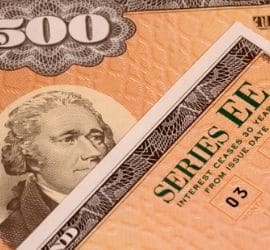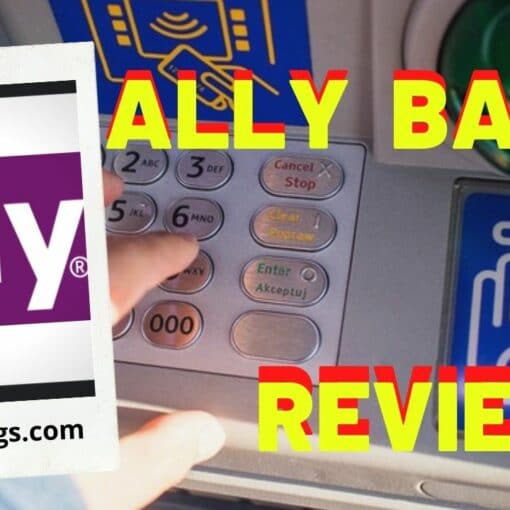Series EE Bonds – Government E Bond – EE Bond
What are Series EE Bonds?
 The Series EE Bond is often referred to as a Patriot Bond or a Savings Bond. It is a non-marketable, interest-bearing U.S. government bond. These bonds are guaranteed to at least double in value over the 20-year initial term. Some Series EE bonds have interest-paying lives that extend beyond the original 20-year maturity date. They can continue to earn interest up to 30 years from the date of issuance. Coupon rates for Series EE Bonds are determined at the time they are issued. They are based on a percentage of the long-term Treasury rates.
The Series EE Bond is often referred to as a Patriot Bond or a Savings Bond. It is a non-marketable, interest-bearing U.S. government bond. These bonds are guaranteed to at least double in value over the 20-year initial term. Some Series EE bonds have interest-paying lives that extend beyond the original 20-year maturity date. They can continue to earn interest up to 30 years from the date of issuance. Coupon rates for Series EE Bonds are determined at the time they are issued. They are based on a percentage of the long-term Treasury rates.
The U.S. Treasury’s savings bond program was introduced in 1935 to encourage Americans to save money and invest in America. Original savings bonds were printed on paper, but that is no longer the case. The Treasury has adapted to modern times and sells savings bonds and other securities through the TreasuryDirect.gov website.
The federal government began issuing paper EE bonds in July 1980. Paper EE bonds are issued at a discount of 50% of their face value. The government offers them in denominations (face value) of $50, $75, $100, $200, $500, $1,000, $5,000 and $10,000. Generally, a client may spend up to $30,000 (that is, $60,000 face value) per calendar year on paper EE bonds. The federal government began issuing electronic EE bonds in May 2003. Electronic bonds are not issued at a discount, but rather are issued only at face value. Generally, a client may spend up to $30,000 per calendar year on electronic bonds. The chart below summarizes the annual purchase limitations. (Source: journalofaccountancy.com)
- Series EE Bonds are interest-bearing U.S. government savings bonds. They are guaranteed to at least double in value over their typical 20-year initial terms.
- Some Series EE bonds pay interest beyond the original maturity date, up to 30 years from issuance.
- There is a minimum investment requirement for EE bonds of $25.00.
- Investors may purchase up to $10,000 in these bonds each calendar year.
How Series EE Bonds Work
Series EE bonds are one of the two types of savings bonds issued by the US Treasury. The other type is Series I bonds. Series EE bonds cannot be bought or sold in the open market, and are hence classified as non-marketable securities.
Series EE bonds issued after May 2005 are assigned semi-annual fixed coupon rates on May 1 and November 1. The rates apply to all issuances for the ensuing six months. Bonds issued after each date increase in value monthly, but interest payments are handed out semiannually. (Source: investopedia.com)
Series EE bonds are considered ultra-safe, low-risk investments. Interest is typically exempt from state and local taxes. However, they are subject to federal taxes, but only in the year in which the bond matures or is redeemed. EE Bonds may be purchased by U.S. citizens, official U.S. residents, minors, and all U.S. government employees.
Series EE Bonds – Details
Series EE bonds are a direct descendant of the Series E savings bond. The original Series E was known as the War Bond and helped finance the American participation in World War II.
- Series EE bonds can be purchased with a face value of as little as $25.
- Face values are also available in penny increments over the initial $25. So, you could buy a bond for $25.28 if you chose.
- The bonds are not issued on paper. Accounts are maintained online.
- The maximum amount that one buyer can purchase in a year is $10,000.
- The bonds are issued to a single owner and cannot be re-sold in the secondary market.
Double Value Guarantee and Redemption
Series EE bonds are guaranteed by the U.S. government to at least double in value over the term of the bond, which is commonly 20 years. At maturity, the owner of the bond can redeem the principal. But, there is an option to let it collect additional interest for another 10 years beyond the maturity date. Investors cannot redeem the bond before holding it for at least one year. After the first year, they can be cashed in at any time but will forego earning additional interest. If redeemed within five years of purchase, there is a three-month interest penalty that will be applied.
BONDS CASHED BEFORE 5 YEARS
Bonds cashed before 5 years are subject to a 3-month interest penalty. For example, if you cash a bond after 18 months you will get 15 months’ worth of interest. The savings bond program encourages Americans to save for longer-term goals such as education or retirement. This rewards longer-term bondholders who then benefit from higher 5-year rates over the full life of the bond. (Source: treasury.gov)
Series EE Bonds – Interest Rate
The interest rate is fixed for 20 years at the time it is issued. The government may adjust the rate after the 20th year. Rates paid on series EE bonds are set twice a year, in May and November, and remain the same for all bonds issued during the following six-month period. As an example, for the six months ending Nov. 30, 2019, the interest rate on Series EE bonds was 0.10%.
The buyer of an electronic Series EE bond pays the full-face-value of the bond upfront. If compound interest does not double its worth in 20 years, the U.S. Treasury commits to making up the difference. Interest income from EE bonds is exempt from state and local taxes but not from federal taxes. The owner may receive tax relief if the funds go to funding qualified higher education. Series EE bonds issued before June 2003 were purchased at half the face value, with the promise that they would double to face value over 20 years. The interest for those older bonds is calculated on the payment amount, not on face value. (Source: investopedia.com)
Are Series EE Bonds and Patriot Bonds Different?
Paper EE bonds were re-issued as Patriot Bonds after the Sept. 11, 2001, terrorist attacks. They are identical in every other way to the paper Series EE Bonds. Bonds purchased through a financial institution after Dec. 10, 2001, have the words “Patriot Bond” printed on the top half of the bond certificate. The words are located between the Social Security Number (SSN) and the issue date. Financial institutions no longer issue Series EE bonds in paper form, but the paper Patriot Bonds can still be cashed or converted into electronic bonds. Series EE bonds don’t need to be reissued to correct small typographical errors in names, addresses, or Social Security numbers.
How Do You Buy Series EE Bonds?
Series EE savings bonds can be purchased online through the TreasuryDirect electronic platform. The transaction is straightforward if you’re an American citizen with a valid Social Security Number. Savings bonds can be purchased at face values ranging from $25 to $10,000. For example, if you want a $100 savings bond, you pay that amount to the Treasury. Long term Treasury bonds, corporate bonds, and other debt instruments are traded on global markets every day. However, savings bonds are nonmarketable. This means the bonds can’t be bought or sold on any secondary market. Once you purchase, the bonds are in your name until such time as you cash them in.
Minimum and Maximum Requirements for Series EE Bonds
There is a $25 minimum investment requirement for Series EE bonds. The maximum each investor may purchase is $10,000 each calendar year. Furthermore, bondholders must hold onto these investments for at least twelve months, before they can redeem the bonds. If you choose to redeem the bonds within five years, you will be docked three months of accrued interest payments. Since EE bonds earn interest for up to 30 years, the longer they’re held, the more they’re worth. Paper bonds were issued at a 50% discount to par, while bonds electronically sourced through TreasuryDirect are purchased at face value. Electronic Series EE bonds are still guaranteed to be worth twice their original value at the first maturity date. This is typically 20 years after the date of the issue.
- $25 minimum investment requirement for Series EE bonds.
- $10,000 maximum for each investor each calendar year.
- One year minimum holding period – bondholders must hold onto these investments for at least twelve months before they can redeem the bonds.
- 3-month interest penalty – If you choose to redeem the bonds within five years, you will be docked three months of accrued interest payments.
- Interest up to 30 years – Since EE bonds earn interest for up to 30 years, the longer they’re held, the more they’re worth.
- Paper bonds were issued at a 50% discount from face value. For example, a $100 face value savings bond costs $50 to purchase.
- Electronic bonds sourced through TreasuryDirect are purchased and issued at face value.
- Electronic Series EE bonds are still guaranteed to be worth twice their original value at the first maturity date. This is typically 20 years after the date of the issue.
Calculating the Value of Savings Bonds
To calculate the value of your savings bonds, you’ll need to know four things:
- Bond type
- Denomination
- Serial number
- Issue date.
Once you have this information, you can use the US government website to find out how much your bond is worth right now. Just log on to treasurydirect.gov, which is run by the U.S. government. Once on the site, you will find a calculator. You will also find detailed instructions on determining your bond’s current and future value. The site also explains how to build and save an inventory of bonds, and how to find the interest to report on your taxes. For tax purposes, you only need to report the interest when the bonds mature.
How to Cash in Series EE Bonds
Paper Series EE Bonds
Paper savings bonds can typically be cashed in at your bank or credit union. Usually, you need to be a regular customer for the bank to provide this service. If you plan to visit a financial institution where you’re not a member or customer, you may want to see if it will cash your bond before you visit. Check with the bank to confirm what documents you’ll need to bring. In general, you need to provide:
- Your paper savings bond
- Government Issued Identification, such as a driver’s license or passport
- If you’re the beneficiary and not the original owner you will need a copy of the owner’s death certificate
Savings bonds can’t be cashed in by just anyone. They must be redeemed by the bond owner or co-owner. This includes “survivors,” or people named on the bond who inherited ownership after the original owner passed away. If you bought the savings bond through an auction site like eBay, you are not the registered owner. A savings bond is nontransferable. Therefore, you can’t cash in the bond.
Options for Redemption
- A parent may cash in a child’s savings bond if the child is too young to sign the request for payment. Also, the child must live with the parent, or the parent must have legal custody of the child.
- Legal ownership – Anyone who wishes to cash in a bond needs to present evidence of the legal right to do so.
- At the bank – You can sign each bond and receive the cash value. Once you’ve cashed in your bond, the bank will either hand you a 1099 tax form or mail it to you by the end of the tax year.
- By Mail – Paper bonds can also be cashed via mail. To cash in by mail you’ll need to download or order an FS Form 1522 from the U.S. Department of Treasury, get your signature certified, and mail the form to the address noted on the form.
Electronic Series EE Bonds
Electronic bonds can be cashed in by logging into your TreasuryDirect account. Then, set up a direct deposit to your checking or savings account. The cash amount may be credited to your bank account within two business days.
Why Buy Series EE Bonds?
Savings bonds, like other fixed-income securities, lack the potential capital appreciation of equities. But savings bonds don’t carry the volatility of the stock market. For individual investors, savings bonds and other types of bonds should be weighed within the context of risk appetite and longer-term portfolio strategy and goals.
- Tax Advantages – Series EE savings bonds and Series I savings bonds offer some tax advantages. According to TreasuryDirect, interest on savings bonds is subject only to federal tax, not state or local taxes. Also, if proceeds are used toward certain qualifying education expenses, you may not have to pay federal tax.
- A Gift that keeps on giving – U.S. savings bonds can be “used as a gift for any occasion—birthdays, weddings, graduations, births,” or other special events, according to the Treasury Department. The deferred, yet essentially guaranteed payout structure is one reason savings bonds have long been a go-to for grandparents welcoming grandkids into the world.
TAX ADVANTAGES
Interest earned on your Series EE bonds is exempt from state and local income taxes. You can defer federal income tax until you redeem the bonds or they stop earning interest after 30 years. This means you can plan ahead and choose when might be the best time to realize income for tax purposes. And, since your interest isn’t taxed until you redeem a bond your savings grow faster. There are also special tax benefits available for education savings. If you qualify, you can exclude all or part of the interest earned on Series EE bonds from income when the bonds are redeemed to pay for post-secondary tuition and fees. (Source: treasury.gov)




